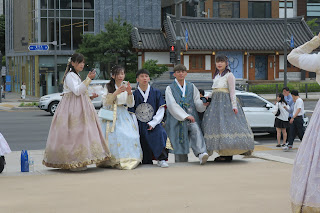Changdeokgung (literally, "The Palace of Prospering Virtue"), also known as
Changdeokgung Palace or Changdeok Palace, is set within a large park in Jongno
District, Seoul, South Korea.
It is one of the "Five Grand Palaces" built by the kings of the Joseon dynasty
(1392–1897). As it is located east of Gyeongbok Palace, Changdeokgung—along
with Changgyeonggung—is also referred to as the "East Palace" (Donggwol).
|
Main gate (Donhwamun).
The main palace gate. Built in 1412, Donhwamun has a two-story
pavilion-type wooden structure, and is the largest of all palace gates.
-
Donhwamun was burned down during the Japanese invasion of 1592 and was
restored in 1608.
|
|
Changdeokgung Palace map.
Today there are 13 buildings remaining on the palace grounds and 28
pavilions in the gardens, occupying 110 acres (45 hectares) in all.
|
|
Jinseonmun gate.
The name 'Jin Seon' means 'speaking true words with the king'.
-
As this is the entrance to the throne where the king sits, it carries
the wish for a virtuous rule.
-
During king Yeongjo's reign in the mid-1700s, the Shinmungo was
situated here. It was a large drum which people could hit when they
were the subject to a misdeed, and wished to beseech the king's
wisdom.
|
|
Walking towards Injeongmun gate.
Once you enter through Jinseonmun, you reach a large yard that has
Injeongmun Gate to the left, and Sukjangmun Gate to the front.
|
|
Injeongmun gate.
Injeongmun is the main gate of Injeongjeon, the main hall of
Changdeokgung Palace.
-
Many kings including Hyojong, Hyeonjong, Sukjong and Yeongjo of Joseon
Dynasty held their coronation ceremony in this gate.
|
|
Nakseonjae Complex.
The Nakseonjae Complex is a residential compound built in 1847 during
the reign of King Keonjong.
-
Queen Myeongheon, the wife of Heonjong, was unable bear a child for
the king. Therefore, Heonjong took a concubine by the name of
Gyeongbin to bear his child. Nakseonjae was built for Gyeongbin in an
isolated corner at Changdeokgung Palace.
-
Nakseonjae Pavilion was a library built for the king where he would
read and paint. Seokbokheon was the residence of Gyeongbin. Sugangjae
was built for Queen Sunwon, the grandmother of Heonjong.
-
A garden can be found in the rear of the residence. Nearby, is a
simple and elegant pavilion known as Sangryangjeong, or Pyeongwonru
before the Japanese occupation. This pavilion was used for rest and
offered a beautiful view of the palace area below.
|
|
King's residence (Huijeongdang).
Huijeongdang was the king's private residence, later used as a
conference hall.
-
Originally the king's bed chamber, it became his workplace after
Seonjeongjeon was deemed too small for conducting routine state
affairs.
-
The original Huijeongdang was destroyed by a fire in 1917. The
reconstructed structure is completely different from the original due
to recent Western influences.
-
Wooden floorboards and carpets, glass windows, and chandeliers can be
seen inside the building.
|
|
King's Council hall and gate (Seonjeongjeon and Seonjeongmun).
An office for ruling officials. The king held daily meetings with
ministers, reported on state affairs and seminars here.
-
Seonjeongjeon Hall is where kings worked and discussed state affairs
with their subjects.
-
Seonjeongjeon is a small one-story building composed of 3-kan(a unit
of measurement referring to the distance between two columns) front
space and 3-kan side space.
-
Although it was used as the king's office, the queen occasionally held
events here along with the king. During the reign of King Seongjong,
his queen threw parties for the elderly and held events to promote
sericulture in the hall.
-
There is no partition wall between the columns of the building, so one
can never feel a sense of stuffiness here. The ceiling is decorated
with dancheong (various designs painted in bright colors).
-
Seonjeongjeon is the only remaining royal building that has a roof of
blue glazed tiles though several other palace buildings had been
roofed with such tiles before the Japanese Invasion of Korea in 1592.
The tiles are similar to those produced in Ganghwado Island by
Buddhist Monk Yugyeon.
|
|
Throne hall (Injeongjeon).
The throne hall of Changdeokgung, it was used for major state affairs
including the coronation of a new king and receiving foreign envoys.
-
Originally built in 1405, it was rebuilt in 1610 after being burned
down during the 1592 Japanese invasion, and a third time in 1804 after
being destroyed by a fire.
|
|
Hospital hall (Yakbang).
The building to the East of Okdang is called Yakbang, which served as a
hospital of sorts.
-
Members of Yakbang went into emergency shifts once anything unexpected
occurred concerning the king's health.
-
As they checked on the king's health almost every single day, they
were the closest to the king among the Western Gwollaegaksa.
|
|
Leaving Changdeokgung Palace.
|
See also
Source
Location




































